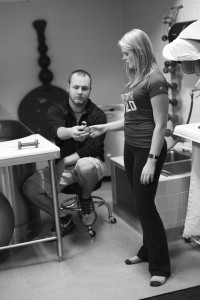
Article reposted from The Concordian
Author: BRADY DRAKE
Usually, college wrestling meets are reserved for members of collegiate teams. However, the Finn Grinaker Cobber Open, held Nov. 18, allowed for wrestlers not affiliated with a school to enter as unattached contestants.
Although Derrick Grieshaber, a graduate assistant athletic trainer at Concordia College, had not wrestled since his sophomore year as an undergraduate in 2012-2013, he decided to take advantage and enter the Cobber Open.
Though he lost all three of his matches, including one at the hands of a University of Minnesota wrestler, he is happy he gave it a shot.
“I’m absolutely glad that I did it,” Grieshaber said.
Lindsey Larson, a fellow graduate assistant athletic trainer in the NDSU program that also works at Concordia, was impressed by his effort.
“I was definitely impressed with what he did, being that he only had a month to get ready,” Larson said. “Especially for having to face Big Ten competition in his first match. Not a lot of people had to do that.”
As an undergraduate, Grieshaber wrestled for Lindenwood University in Belleville, Illinois, before quitting to pursue his goal of becoming an athletic trainer.
“I had to quit for my clinicals,” Grieshaber said. “So, it was kind of like well, we stop here.”
But that was not his final stop. Though he only started training a month and a half before the Cobber open, Grieshaber had been wrestling with the idea of competing again for awhile.
“Last year, it kind of popped up like hey this would be fun,” Grieshaber said. “Instead of having to work, this would be something different to do, and I kind of had a chip on my shoulder because I never really got to finish my career and see if I could still do it.”
Grieshaber almost missed his last chance to wrestle because of athletic training, again. The meet was scheduled on what would have been the first playoff game for a Concordia football team that just missed an at-large bid to the NCAA tournament. If they would have made it, Grieshaber would have been taping ankles instead of taking his last shot.
When one door closes another one opens, and when the Cobber football team missed the playoffs, Grieshaber was assured a final chance to compete in his longtime favorite sport.
And although the sport is his favorite, Grieshaber says that it is not enjoyable.
“It’s a sport you train to win,” Grieshaber said.
Ricquel Ramsbottom, a student athletic trainer from MSUM, was surprised by Grieshaber’s decision to wrestle, but she thought that his athletic training background would give him an advantage.
“Derrick is the type of AT [athletic trainer] who has ice water in his veins,” Ramsbottom said. “Cool, calm, collected, and always well-hydrated.”
Grieshaber waited until he was eliminated to toss back on his khakis and begin training athletes, but had he been injured during the match, he probably would have played the role of athletic trainer on himself.
“I probably will not let anybody touch me if I do get injured,” Grieshaber said prior to the meet. “Depending on the severity of the injury, I’ll probably just pick myself up or do something to fix myself or just not say anything to anyone until the next day. You know, like a typical athlete.”
After the experiment, Grieshaber insists that he’s finally done.
“This will for sure be a last hurrah type of deal,” Grieshaber said. “My body, with the amount of training I’ve done in the past month and the weight cut, it’s official this will be my last deal.”
For now you can find him in the bowels of the Olson/Memorial complex, but perhaps one day he will get that itch again and come to a wrestling mat near you.

